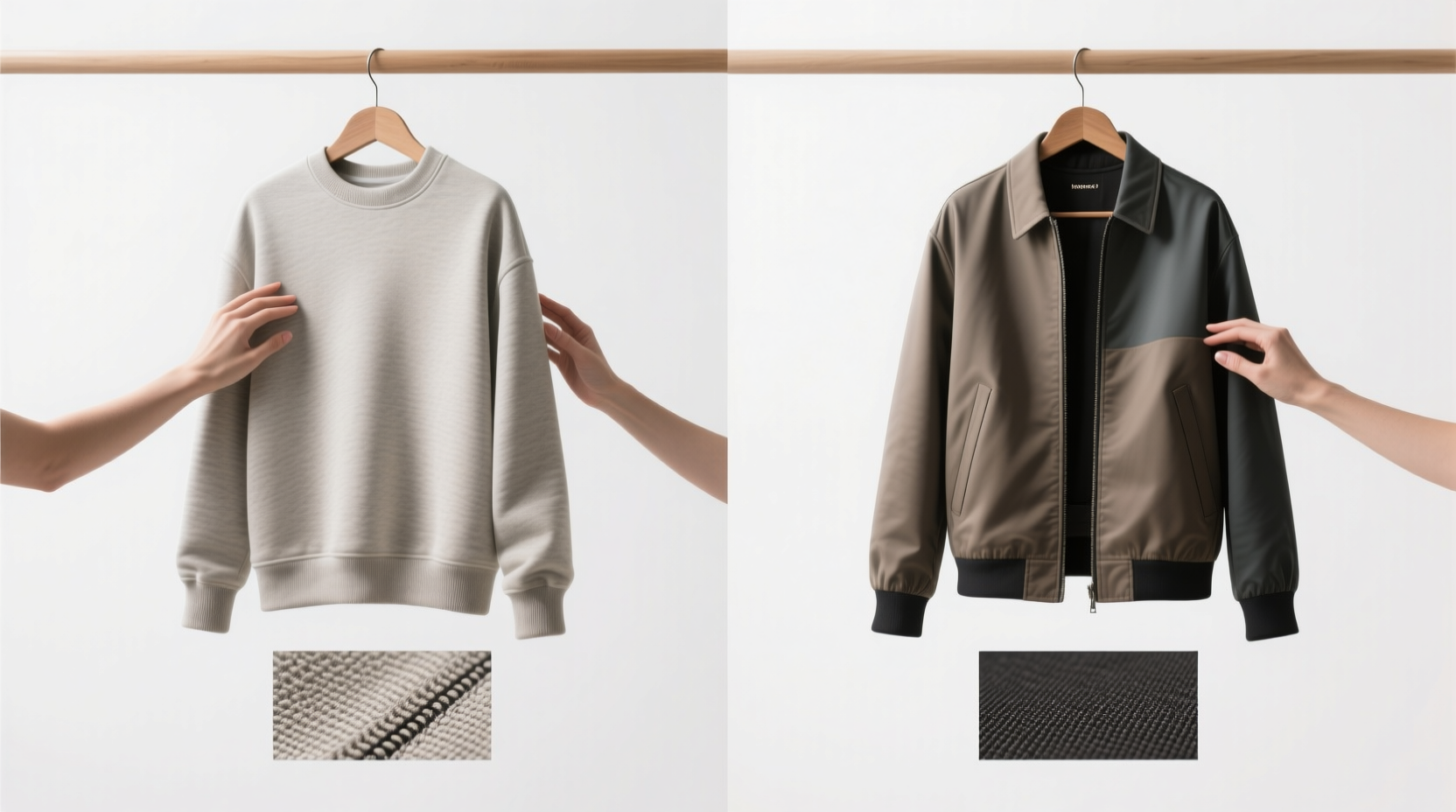You’re sitting at your desk, coffee gone cold, staring at fabric swatches and wondering: Should I go with sweatshirts or jackets for my next drop?
I’ve been there. More times than I’d like to admit.
At Fexwear, we’ve helped hundreds of brands — from garage startups to established names — make this exact call. And let me tell you, the wrong choice doesn’t just cost money. It costs trust. It costs momentum. It costs your brand’s credibility.
So let’s cut the fluff. No buzzwords. No recycled blog content. Just real talk about sweatshirt vs jacket — what they really do, who they’re for, and how to pick the right one without burning cash or alienating your customers.
Sweatshirt vs Jacket: Material and Fabric
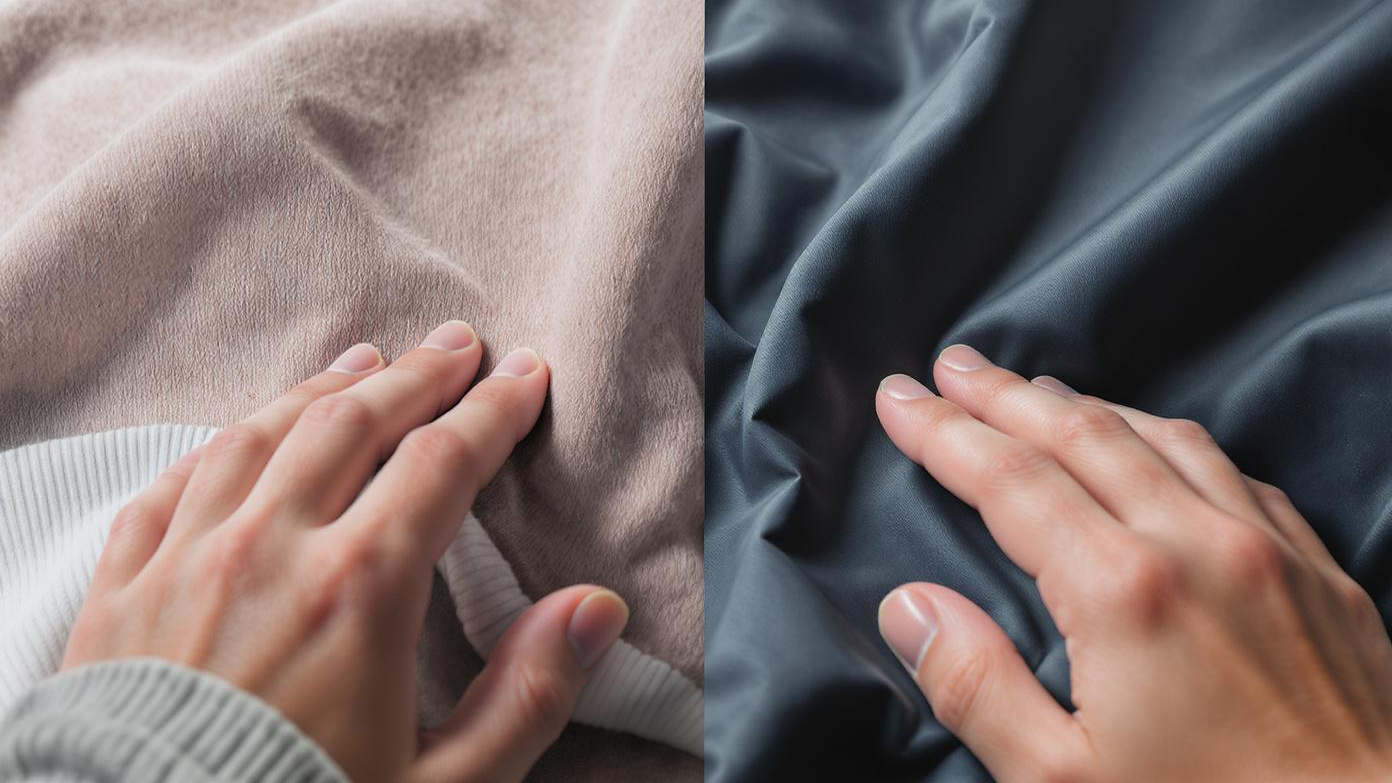
Let’s start with the basics — because if you get this wrong, everything else falls apart.
I once had a client — a fitness influencer launching her first apparel line — who wanted “cozy, breathable hoodies” but insisted on using 100% polyester. She thought it was “performance fabric.” Spoiler: it wasn’t. The first batch arrived, and people complained the sweatshirts sweated more than they did. No breathability. No softness. Just a plastic bag with a hood.
Mistake? Confusing jacket materials with sweatshirt function.
Sweatshirts: Built for Comfort, Not Combat
Sweatshirts are about feel. They’re the garment equivalent of a slow morning. You wear them when you want to be warm, but not hot. When you want to move, but not perform.
The gold standard? Cotton or cotton-blend fleece, usually between 200–350 GSM. That’s grams per square meter — a number that tells you how heavy and insulating the fabric is.
- 200–250 GSM: Lightweight, breathable. Great for spring or indoor wear.
- 300+ GSM: Thick, cozy. Ideal for fall, winter layering, or that oversized streetwear look.
At Fexwear, we default to 300 GSM cotton-poly fleece for most custom sweatshirts. Why? It holds shape, resists pilling, and prints like a dream. You can learn more about our fabric selection process in our detailed guide on fabric recommendations for sportswear .
And yes — we’ve tested bamboo blends, organic cotton, recycled poly. They all have their place. But if you’re launching your first line, stick with proven performers.
Jackets: Built for Weather, Not Warm Fuzzies
Now, jackets? They’re not about comfort. They’re about survival.
You don’t wear a jacket because it feels nice. You wear it because the wind is howling, the rain is sideways, or your customer is biking through a January commute.
So the materials shift hard:
- Denim jackets: 100% cotton or cotton-poly — durable, casual, timeless.
- Leather jackets: Cowhide or lambskin — premium, structured, statement-making.
- Synthetic jackets (nylon, polyester): Water-resistant, windproof, lightweight. The go-to for performance outerwear.
- Puffer jackets: Nylon shell + down or synthetic insulation — maximum warmth, minimum breathability.
Here’s a story: A client in Norway wanted a “lightweight jacket” for trail runners. We used a 30D ripstop nylon with DWR coating — thin, strong, water-shedding. He thought it looked “too flimsy.” Then it rained for three days straight. His customers didn’t care how it looked. They cared that they stayed dry.
That’s the jacket mindset: function over form.
Sweatshirt vs Jacket: Fabric Comparison Table
Bottom line:
If your customer is lounging, commuting, or doing light movement — go sweatshirt.
If they’re facing weather, wind, or need protection — go jacket.
And don’t try to fake it. I’ve seen brands slap a “performance” label on a 280 GSM cotton hoodie and call it “all-weather ready.” It’s not. It’s a sweatshirt pretending to be something it’s not.
Sweatshirt vs Jacket: Design and Structure
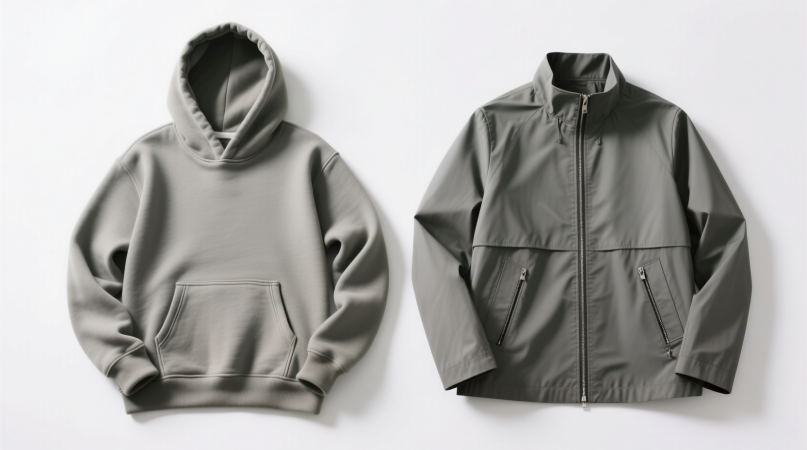
Design isn’t just about looks. It’s about intent.
And when you look at sweatshirts and jackets, you’re seeing two completely different philosophies.
Sweatshirts: Minimalism with a Message
Sweatshirts are the anti-design design.
No zippers. No buttons. No complex closures. Just a pullover, a hood, and maybe a pocket.
That simplicity is the point.
It’s why sweatshirts dominate streetwear, athleisure, and campus fashion. They’re blank canvases. You throw a bold chest print, a back graphic, or a subtle embroidered logo — and suddenly, it’s a statement.
But here’s the thing a lot of new brands miss: the fit has to be right.
I worked with a startup that wanted an “oversized hoodie” for their Gen Z audience. We made it roomy — but not sloppy. The key? Slight drop shoulders, longer sleeves, and a high neck. Not too baggy, not too tight. Just “I woke up like this” energy.
And because it was clean, the branding popped. No distractions. Just fabric, fit, and message.
If you’re going the sweatshirt route, think about:
- Pullover vs zip-up (zip-ups are more versatile, but less “pure” streetwear)
- Kangaroo pocket or no pocket (pocket = classic, no pocket = sleek)
- Hood lining color (contrast linings are a small detail that screams “we thought about this”)
Jackets: Structure is Everything
Now, jackets? They’re engineered.
Zippers. Buttons. Hoods. Storm flaps. Adjustable cuffs. Interior pockets. Venting systems.
Every element has a job.
And that’s why jackets are harder to get right — but when they are, they build brand authority.
I remember a brand that came to us wanting a “premium jacket” for their corporate clients. They didn’t want flashy. They wanted trusted. So we went with a minimalist trench-style jacket — clean lines, hidden zippers, matte black hardware, and a subtle interior label with their logo.
No loud branding. No back prints. Just quality.
And guess what? Their customers wore it to meetings, to airports, to client dinners. It became a symbol of the brand — not because of a logo, but because of how it felt to wear it.
That’s jacket power.
When Design Goes Wrong
Here’s a cautionary tale: A brand wanted a “hybrid sweatshirt-jacket.” So we made a hoodie with a water-resistant outer shell. Sounds smart, right?
But then they tried to market it as “all-weather performance wear.” Problem? It wasn’t breathable. People wore it for 20 minutes and were drenched in sweat.
Lesson: Don’t hybridize just because you can.
If you need weather protection, go jacket.
If you need comfort, go sweatshirt.
Trying to do both usually means doing neither well.
Sweatshirt vs Jacket: Functionality and Use

Let’s cut to the chase: What is your customer actually doing when they wear this?
Because that’s the only question that matters.
Sweatshirts: The Go-To for “Just Living”
Sweatshirts are for:
- Lounging at home
- Running errands
- Casual meetups
- Light workouts (yoga, walking, gym)
- Layering under coats
They’re not for performance. They’re for presence.
And that’s why they work so well for brands that sell lifestyle, not just clothing.
Think about it: when someone wears your sweatshirt, they’re not just wearing a product. They’re wearing your brand in their daily life — at home, with friends, on the weekend.
That’s powerful.
But — and this is a big but — if you position a sweatshirt as “performance wear,” you’re setting yourself up for returns, bad reviews, and broken trust.
I had a client who called their cotton hoodie a “training essential.” People wore it to CrossFit. It soaked up sweat like a sponge. They hated it.
Don’t do that.
Jackets: For When the World Fights Back
Jackets are for:
- Commuting in rain or wind
- Outdoor adventures
- Travel
- Seasonal transitions
- Looking put-together in bad weather
They’re tools.
And tools need to work.
I worked with a cycling brand that needed a lightweight jacket for early-morning rides. We used windproof, breathable softshell fabric with underarm vents and a drop tail to protect the lower back.
No gimmicks. Just function.
And their customers loved it — not because it looked cool (though it did), but because it solved a problem.
That’s the jacket advantage: it earns loyalty by being useful.
Use Case Comparison Table
Pro tip: If your brand is about community, comfort, or casual style — start with sweatshirts.
If you’re selling performance, protection, or professionalism — lean into jackets.
Sweatshirt vs Jacket: Seasonality
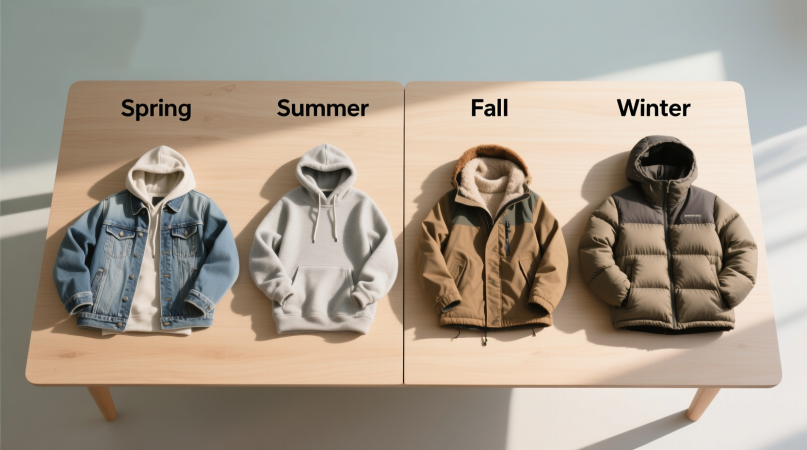
Seasonality isn’t just about weather. It’s about timing your launch.
And if you get this wrong, you’ll be stuck with dead stock and a sinking P&L.
Sweatshirts: The Transitional Workhorse
Sweatshirts shine in:
- Fall (cool mornings, crisp air)
- Spring (unpredictable temps)
- Winter layering (under coats)
They’re not for deep winter. Not for summer.
But they are for 8 months of the year in most climates.
That’s why they’re so popular with brands doing back-to-school drops, holiday gifting, or year-round casual lines.
We once helped a university store launch custom hoodies in August. Sold out in two weeks. Why? Students wanted something cozy for dorm life, and the brand nailed the timing.
Jackets: Season-Specific, High-Impact
Jackets are more targeted:
- Winter jackets: Heavy insulation, down, parkas — for cold climates
- Rain jackets: Waterproof, packable — spring and fall
- Windbreakers: Lightweight, breathable — summer and early fall
- Denim/leather jackets: Year-round, fashion-driven
The key? Drop them when people need them.
I had a client who launched a puffer jacket in March. Bad move. People were already thinking about spring. The jackets sat.
Next year, they launched in October. Sold out in days.
Seasonal Planning Guide
Pro move: Split your jacket line into seasonal drops. Don’t try to sell heavy winter gear in May.
And for sweatshirts? They’re your evergreen product. Always relevant, always wearable.
Sweatshirt vs Jacket: Branding and Customization

This is where most brands mess up.
They treat branding like a checkbox: “Add logo here.”
But how you brand matters just as much as where.
Sweatshirts: The Billboard Effect
Sweatshirts are ad space.
Big chest prints. Full back graphics. Sleeve logos. Patchwork.
They’re perfect for:
- Startups building awareness
- Gyms and fitness studios
- Influencers and content creators
- Limited-edition drops
I worked with a yoga brand that wanted to stand out. We did a collaboration hoodie with a local artist — full back print, limited run. They sold out in 48 hours. Not because it was the most functional garment, but because it was desirable.
That’s the sweatshirt advantage: high visibility, high shareability.
Jackets: The Quiet Authority
Jackets? They’re about credibility.
You don’t slap a giant logo on a leather jacket and call it premium.
You do:
- Small chest embroidery
- Custom zipper pulls
- Branded interior lining
- Hidden care tags with your logo
It’s subtle. It’s sophisticated. It says, “We didn’t have to shout. You already know who we are.”
We helped a tech startup launch at a conference with custom windbreakers — black, minimalist, small embroidered logo. No graphics. No hype. But every attendee wanted one.
Because it felt exclusive.
Branding Strategy Table
If you’re just starting out, sweatshirts are your best friend.
If you’re scaling and want to build brand equity, jackets are your power move.
Sweatshirt vs Jacket: Cost and Production
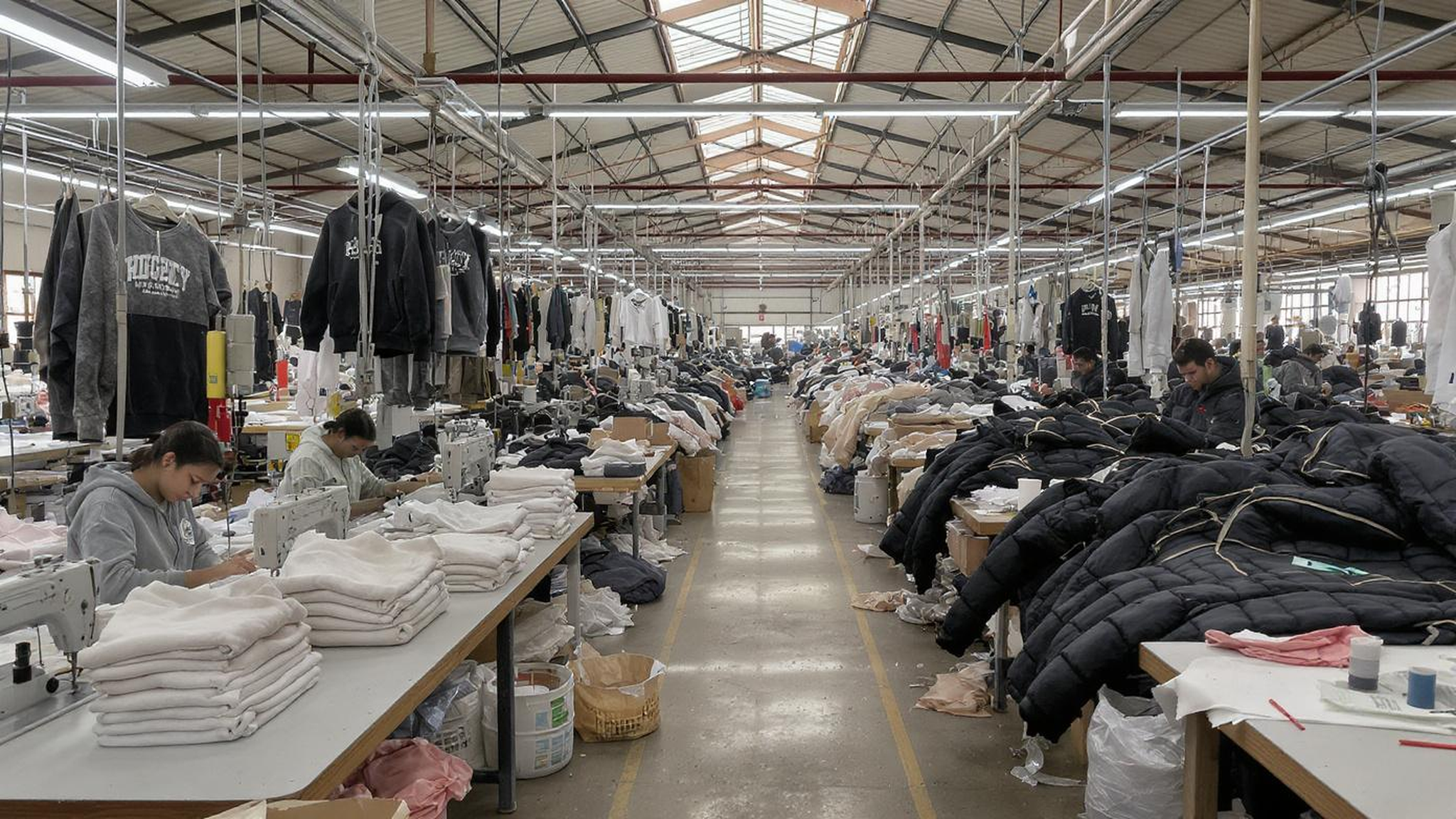
Let’s talk money.
Because at the end of the day, this isn’t just about design. It’s about what you can afford to produce — and sell.
Sweatshirts: Fast, Cheap, Scalable
- Lower material cost (cotton is cheaper than nylon or leather)
- Simpler construction (fewer pieces, no linings)
- Faster production (one worker can make 50+ per day)
- Lower MOQs (you can start at 30–50 units)
At Fexwear, we’ve done small-batch sweatshirt runs for startups with MOQs as low as 30. And because the process is streamlined, we can turn it around in 2–3 weeks.
That’s why sweatshirts are perfect for testing markets, launching with limited budget, or doing influencer collabs.
Jackets: Higher Cost, Higher Reward
- More materials (outer shell, lining, insulation, zippers, trims)
- Complex assembly (multiple stages, quality checks)
- Longer production time (2–3x longer than sweatshirts)
- Higher MOQs (usually 100+ for cost efficiency)
But — and this is important — jackets have higher perceived value.
A $40 sweatshirt feels like a casual buy.
A $120 jacket feels like an investment.
So even if your margin is tighter, the lifetime value of a jacket customer is often higher.
Production Comparison Table
If you’re bootstrapping, start with sweatshirts.
If you’ve got funding and want to scale, invest in jackets.
And remember: at Fexwear, we offer low MOQs, fast turnaround, and free design support — whether you’re making 30 hoodies or 500 puffers. Check out our Small Seller Support Program to see how we help brands like yours get off the ground.
Wrap-Up
Look, I’m tired. You’re tired. We’re all tired of content that says nothing.
So here’s the truth: Sweatshirts sell volume. Jackets sell prestige.
One keeps your brand visible. The other makes it unforgettable.
Pick the right one — not based on trends, but on what your customer actually needs.
And if you’re still not sure? Just reach out. We’ll help you decide — no pitch, just real talk.
FAQs
1. Are sweatshirts good for workouts?
Only light ones. If it’s yoga or a walk, sure. But for anything intense, you’ll want moisture-wicking fabric — not cotton.
2. Can I wear a jacket casually?
Absolutely. Denim, field, and bomber jackets work great with jeans and sneakers.
3. Which has better branding space — sweatshirt or jacket?
Sweatshirts win for bold graphics. Jackets win for subtle, premium branding.
4. How do I choose fabric for a custom sweatshirt?
Stick to 300 GSM cotton-blend fleece for balance. Want eco-friendly? Try organic cotton or recycled poly.
5. Do jackets last longer than sweatshirts?
Generally, yes — especially leather or nylon. But it depends on care and use.
6. Can I make a jacket with a low MOQ?
It’s harder, but yes. We’ve done 50-unit jacket runs. Just expect higher per-unit cost.
7. Should I start with sweatshirts or jackets?
Most brands start with sweatshirts. Lower risk, faster feedback.
8. How do I avoid looking cheap with my custom apparel?
Fit and fabric. A well-fitting $30 sweatshirt beats a sloppy $80 jacket every time.
Call to Discussion
I’ve seen brands blow $20K on the wrong outerwear drop. I’ve also seen startups sell out in 24 hours because they picked the right garment at the right time.
It’s not about budget. It’s about clarity.
So what’s your take?
Are you team sweatshirt or team jacket for your next launch?
Or have you tried a hybrid that actually worked?
I’ve said my piece. Your turn.

